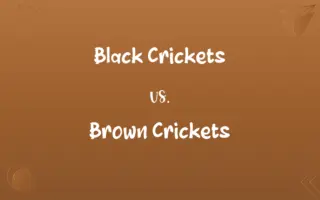Allosaurus vs. Tyrannosaurus: Know the Difference

By Shumaila Saeed || Published on February 21, 2024
Allosaurus was a large Jurassic predator with long arms, while Tyrannosaurus was a massive Cretaceous carnivore with short arms and immense bite force.

Key Differences
Allosaurus is a genus of large theropod dinosaurs that lived during the Late Jurassic period, about 155 to 150 million years ago. It was characterized by a large skull with dozens of sharp, serrated teeth and relatively long arms with three-fingered hands. Tyrannosaurus, most famously represented by T. rex, existed in the Late Cretaceous period, about 68 to 66 million years ago. This dinosaur is known for its massive skull, powerful jaws, and extremely short forelimbs with two-fingered hands.
Shumaila Saeed
Feb 21, 2024
In terms of size, Allosaurus was large but generally smaller than Tyrannosaurus. Allosaurus could reach up to 30 feet in length and weigh around 2.5 tons. In contrast, Tyrannosaurus was one of the largest meat-eating dinosaurs, with specimens measuring up to 40 feet long and weighing as much as 9 tons.
Shumaila Saeed
Feb 21, 2024
The hunting strategies of these predators were likely different due to their physical differences. Allosaurus may have been a more active predator or scavenger, using its agility and relatively longer arms. Tyrannosaurus, with its enormous bite force, was likely capable of crushing bone, suggesting it could have been both a fearsome hunter and a scavenger.
Shumaila Saeed
Feb 21, 2024
Allosaurus had a lighter, more flexible build compared to Tyrannosaurus. This could imply a lifestyle more adapted to chasing down prey or engaging in complex interactions with other dinosaurs. The robust build of Tyrannosaurus, including its strong hind limbs and massive tail, suggests a powerful yet possibly slower-moving lifestyle.
Shumaila Saeed
Feb 21, 2024
The ecosystems these dinosaurs inhabited were also quite different. Allosaurus roamed the semi-arid floodplains of North America and possibly Europe and Africa. Tyrannosaurus was likely a dominant predator in diverse environments, from coastal forests to inland plains in what is now North America.
Shumaila Saeed
Feb 21, 2024
ADVERTISEMENT
Comparison Chart
Time Period
Late Jurassic (155-150 million years ago)
Late Cretaceous (68-66 million years ago)
Shumaila Saeed
Feb 21, 2024
Physical Features
Large skull, long arms, three-fingered hands
Massive skull, short arms, two-fingered hands
Shumaila Saeed
Feb 21, 2024
Hunting Strategy
Active predator/scavenger, agile
Powerful bite force, bone-crushing
Shumaila Saeed
Feb 21, 2024
ADVERTISEMENT
Allosaurus and Tyrannosaurus Definitions
Allosaurus
Characterized by a large head with sharp teeth and relatively long arms.
The fossilized skull of the Allosaurus displayed its impressive array of teeth.
Shumaila Saeed
Jan 12, 2024
Tyrannosaurus
A massive Cretaceous theropod, famously known as T. rex.
The Tyrannosaurus, particularly the T. rex, is one of the most well-known dinosaurs.
Shumaila Saeed
Jan 12, 2024
Allosaurus
A common genus found in North American dinosaur fossil records.
Many Allosaurus fossils have been unearthed in the western United States.
Shumaila Saeed
Jan 12, 2024
Tyrannosaurus
Noted for its gigantic head, short arms, and powerful jaws.
The Tyrannosaurus had one of the strongest bite forces of any terrestrial animal.
Shumaila Saeed
Jan 12, 2024
Allosaurus
A large Jurassic theropod dinosaur known for its formidable size and predatory nature.
The Allosaurus was a dominant predator in its Jurassic ecosystem.
Shumaila Saeed
Jan 12, 2024
ADVERTISEMENT
Tyrannosaurus
Dominant predator in its environment, possibly an apex predator.
The Tyrannosaurus likely had no natural predators due to its size and strength.
Shumaila Saeed
Jan 12, 2024
Allosaurus
Lived approximately 155 to 150 million years ago.
The Allosaurus roamed the Earth long before the appearance of Tyrannosaurus.
Shumaila Saeed
Jan 12, 2024
Tyrannosaurus
Fossils primarily found in North America.
The discovery of Tyrannosaurus fossils has provided significant insight into the Late Cretaceous period.
Shumaila Saeed
Jan 12, 2024
Allosaurus
Often depicted as a swift and agile hunter.
The Allosaurus was likely an adept hunter, capturing its prey with speed and precision.
Shumaila Saeed
Jan 12, 2024
Tyrannosaurus
Existed around 68 to 66 million years ago.
The Tyrannosaurus was among the last dinosaurs to exist before the mass extinction event.
Shumaila Saeed
Jan 12, 2024
Allosaurus
A very large allosaurid dinosaur of the genus Allosaurus of the late Jurassic Period, having a pair of bony bumps above the eyes. Also called allosaur.
Shumaila Saeed
Jan 10, 2024
Tyrannosaurus
Any of various tyrannosaurid dinosaurs of the genus Tyrannosaurus, having a large head and teeth and short forelimbs, and including T. rex and possibly some other species. Also called tyrannosaur.
Shumaila Saeed
Jan 10, 2024
Allosaurus
A large, carnivorous dinosaur, of genus Allosaurus, that lived in the Jurassic period.
Shumaila Saeed
Jan 10, 2024
Allosaurus
Late Jurassic carnivorous dinosaur; similar to but somewhat smaller than tyrannosaurus
Shumaila Saeed
Jan 10, 2024
Tyrannosaurus
A large carnivorous dinosaur, of the genus Tyrannosaurus, found in North America during the late Cretaceous period.
Shumaila Saeed
Jan 10, 2024
Tyrannosaurus
Large carnivorous bipedal dinosaur having enormous teeth with knifelike serrations; may have been a scavenger rather than an active predator; later Cretaceous period in North America
Shumaila Saeed
Jan 10, 2024
Repeatedly Asked Queries
Where have Tyrannosaurus fossils been found?
Tyrannosaurus fossils have primarily been found in North America.
Shumaila Saeed
Feb 21, 2024
Did Allosaurus hunt in packs?
There is some debate among scientists, but some evidence suggests Allosaurus may have hunted in groups.
Shumaila Saeed
Feb 21, 2024
When did Allosaurus live?
Allosaurus lived during the Late Jurassic period, about 155 to 150 million years ago.
Shumaila Saeed
Feb 21, 2024
What is Tyrannosaurus known for?
Tyrannosaurus is known for its enormous size, powerful jaws, and status as a fearsome predator.
Shumaila Saeed
Feb 21, 2024
How strong was the bite of a Tyrannosaurus?
The bite force of Tyrannosaurus was among the strongest of any land animal, estimated to be around 8,000 pounds per square inch.
Shumaila Saeed
Feb 21, 2024
Could Tyrannosaurus run fast?
There is ongoing debate, but some estimates suggest Tyrannosaurus could run at speeds of up to 25 mph.
Shumaila Saeed
Feb 21, 2024
What did Allosaurus eat?
Allosaurus was a carnivore that likely preyed on large herbivorous dinosaurs.
Shumaila Saeed
Feb 21, 2024
What did Tyrannosaurus use its short arms for?
The function of Tyrannosaurus' short arms is still unclear, though they may have been used for grasping prey or mates.
Shumaila Saeed
Feb 21, 2024
How big was Allosaurus?
Allosaurus could reach up to 30 feet in length and weigh around 2.5 tons.
Shumaila Saeed
Feb 21, 2024
How did Allosaurus hunt?
Allosaurus likely used its agility and sharp teeth to hunt and capture prey.
Shumaila Saeed
Feb 21, 2024
Was Tyrannosaurus the largest carnivorous dinosaur?
Tyrannosaurus was one of the largest, but not the absolute largest. Spinosaurus is a contender for that title.
Shumaila Saeed
Feb 21, 2024
How did the environment of Tyrannosaurus differ from Allosaurus?
Tyrannosaurus lived in a variety of environments, including coastal forests and plains, while Allosaurus inhabited semi-arid floodplains.
Shumaila Saeed
Feb 21, 2024
Is Allosaurus featured in popular media?
Yes, Allosaurus has appeared in various films, documentaries, and books about dinosaurs.
Shumaila Saeed
Feb 21, 2024
What are the main differences between Allosaurus and Tyrannosaurus?
Key differences include the time period they lived in, size, physical features, and possibly hunting strategies.
Shumaila Saeed
Feb 21, 2024
Are Allosaurus and Tyrannosaurus found in the same geological period?
No, Allosaurus lived in the Jurassic period, while Tyrannosaurus lived in the Cretaceous period.
Shumaila Saeed
Feb 21, 2024
Did Tyrannosaurus have any predators?
Due to its size, Tyrannosaurus likely had no natural predators.
Shumaila Saeed
Feb 21, 2024
Were there different species of Allosaurus?
Yes, several species of Allosaurus have been identified, including A. fragilis and A. europaeus.
Shumaila Saeed
Feb 21, 2024
What's the difference in the arms of Allosaurus and Tyrannosaurus?
Allosaurus had longer, three-fingered arms, while Tyrannosaurus had very short, two-fingered arms.
Shumaila Saeed
Feb 21, 2024
Where did Allosaurus live?
Allosaurus lived in what is now North America and possibly Europe and Africa.
Shumaila Saeed
Feb 21, 2024
Share this page
Link for your blog / website
HTML
Link to share via messenger
About Author
Written by
Shumaila SaeedShumaila Saeed, an expert content creator with 6 years of experience, specializes in distilling complex topics into easily digestible comparisons, shining a light on the nuances that both inform and educate readers with clarity and accuracy.








































































